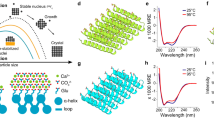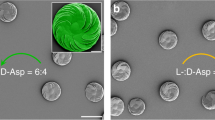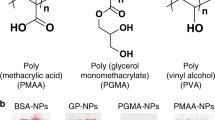Abstract
Many living organisms contain biominerals and composites with finely tuned properties, reflecting a remarkable level of control over the nucleation, growth and shape of the constituent crystals1,2,3,4,5,6. Peptides and proteins play an important role in achieving this control1,7,8. But the general view that organic molecules affect mineralization through stereochemical recognition, where geometrical and chemical constraints dictate their binding to a mineral, seems difficult to reconcile4 with a mechanistic understanding, where crystallization is controlled by thermodynamic and kinetic factors9. Indeed, traditional crystal growth models emphasize the inhibiting effect of so-called ‘modifiers’ on surface-step growth, rather than stereochemical matching to newly expressed crystal facets. Here we report in situ atomic force microscope observations and molecular modelling studies of calcite growth in the presence of chiral amino acids that reconcile these two seemingly divergent views. We find that enantiomer-specific binding of the amino acids to those surface-step edges that offer the best geometric and chemical fit changes the step-edge free energies, which in turn results in macroscopic crystal shape modifications. Our results emphasize that the mechanism underlying crystal modification through organic molecules is best understood by considering both stereochemical recognition and the effects of binding on the interfacial energies of the growing crystal.
This is a preview of subscription content, access via your institution
Access options
Subscribe to this journal
Receive 51 print issues and online access
$199.00 per year
only $3.90 per issue
Buy this article
- Purchase on Springer Link
- Instant access to full article PDF
Prices may be subject to local taxes which are calculated during checkout



Similar content being viewed by others
References
Mann, S. et al. Crystallization at inorganic-organic interfaces - biominerals and biomimetic synthesis. Science 261, 1286–1292 (1993).
Addadi, L., Moradian, L. J., Shay, E., Maroudas, N. G. & Weiner, S. A chemical model for the cooperation of sulfates and carboxylates in calcite crystal nucleation - relevance to biomineralization. Proc. Natl Acad. Sci. USA 84, 2732–2736 (1987).
Sikes, C. S., Yeung, M. L. & Wheeler, A. P. in Surface Reactive Peptides And Polymers: Discovery And Commercialization (eds Sikes, C. S. & Wheeler, A. P.) ACS Symposium Series 444, Ch. 5, 50–71 (ACS Books, Washington DC, 1991).
Mann, S. et al. Crystallization at inorganic–organic interfaces - biominerals and biomimetic synthesis. Science 261, 1286–1292 (1993).
Mann, S., Didymus, J. M., Sanderson, N. P., Heywood, B. R. & Samper, E. J. A. Morphological influence of functionalized and non-functionalized d-alpha,omega-dicarboxylates on calcite crystallization. J. Chem. Soc. Faraday Trans. 86, 1873–1880 (1990).
Berman, A., Addadi, L. & Weiner, S. Interaction of sea urchin skeleton macromoloecules with growing calcite crystals - a study of intracrystalline proteins. Nature 331, 546–548 (1988).
Berman, A. et al. Biological control of crystal texture - a widespread strategy for adapting crystal properties to function. Science 259, 776–779 (1993).
Belcher, A. M. et al. Control of crystal phase switching and orientation by soluble mollusc-shell proteins. Nature 381, 56–58 (1996).
Burton, W. K., Cabrera, N. & Frank, F. C. The growth of crystals and equilibrium structure of their surfaces. Phil. Trans. R. Soc. Lond. A 243, 299–358 (1951).
Teng, H. H., Dove, P. M., Orme, C. A. & DeYoreo, J. J. Thermodynamics of calcite growth: Baseline for understanding biomineral formation. Science 282, 724–727 (1998).
Reeder, R. J. in Carbonates: Mineralogy And Chemistry (eds Reeder, R. J. & Mineralogical Society of America) Vol. II, Ch. 1, 1–47 (Mineralogical Society of America, Washington DC, 1983).
Honess, A. P. & Jones, J. R. Etch figure Investigations with Optically Active Solvents. Technical Paper 35, 667–721 (Pennsylvania State College, Mineral Industries Experimental Station, 1937).
Aizenberg, J. et al. Biologically induced reduction in symmetry - a study of crystal texture of calcitic sponge spicules. Chem. Eur. J. 1, 414–422 (1995).
Didymus, J. M. et al. in Mechanisms And Phylogeny Of Mineralization In Biological Systems (eds Suga, S. & Nakahara, H.) 267–271 (Springer, Tokyo/New York, 1991).
Weissbuch, I., Addadi, L., Lahav, M. & Leiserowitz, L. Molecular recognition at crystal interfaces. Science 253, 637–645 (1991).
Addadi, L. et al. A link between macroscopic phenomena and molecular chirality: crystals as probes for indirect assignment of absolute configuration of chiral molecules. Topics Stereochem. 16, 1 (1986).
Madura, J. D. et al. Interactions of the d-form and l-form of winter flounder antifreeze peptide with the (201) planes of ice. J. Am. Chem. Soc. 116, 417–418 (1994).
Didymus, J. M., Young, J. R. & Mann, S. Construction and morphogenesis of the chiral ultrastructure of coccoliths from the marine alga Emiliania Huxleyi. Proc. R. Soc. Lond. Ser. B 258, 237–245 (1994).
Mann, S., Sparks, N. H. & Blakemore, R. P. Structure, morphology and crystal growth of anisotropic magnetite crystals in magnetotactic bacteria. Proc. R. Soc. Lond. B 231, 477–487 (1987).
Zhao, X. Y., Zhao, R. G. & Yang, W. S. Scanning tunneling microscopy investigation of l-lysine adsorbed on Cu (001). Langmuir 16, 9812–9818 (2000).
Wulff, G. Velocity of growth and dissolution of crystal faces. Z. Kristallogr. 34, 449–530 (1901).
Land, T. A., Martin, T. L., Potapenko, S., Palmore, G. T. & De Yoreo, J. J. Recovery of surfaces from impurity poisoning during crystal growth. Nature 399, 442–445 (1999).
Davis, K. J., Dove, P. M. & De Yoreo, J. J. The role of Mg2+ as an impurity in calcite growth. Science 290, 1134–1137 (2000).
Stipp, S. L. & Hochella, M. F. Structure and bonding environments at the calcite surface as observed with x-ray photoelectron spectroscopy (XPS) and low energy electron diffraction (LEED). Geochim. Cosmochim. Acta 55, 1723–1736 (1991).
Feidenhansl, R. Surface structure determination by X-ray diffraction. Surf. Sci. Rep. 10, 105–188 (1989).
Fenter, P. et al. Surface speciation of calcite observed in situ by high-resolution X-ray reflectivity. Geochim. Cosmochim. Acta 64, 1221–1228 (2000).
Robinson, I. K. X-ray crystallography of surfaces and interfaces. Acta Crystal. A 54, 772–778 (1998).
Albeck, S., Aizenberg, J., Addadi, L. & Weiner, S. Interactions of various skeletal intracrystalline components with calcite crystals. J. Am. Chem. Soc. 115, 11691–11697 (1993).
Stewart, J. J. P. Optimization of parameters for semiempirical methods. 2. Applications. J. Comput. Chem. 10, 221–264 (1989).
Cramer, C. J. & Truhlar, D. G. An scf solvation model for the hydrophobic effect and absolute free energies of aqueous solvation. Science 256, 213–217 (1992).
Breneman, C. M. & Wiberg, K. B. Determining atom-centered monopoles from molecular electrostatic potentials - the need for high sampling density in formamide conformational analysis. J. Comput. Chem. 11, 361–373 (1990).
Chirlian, L. E. & Francl, M. M. Atomic charges derived from electrostatic potentials - a detailed study. J. Comput. Chem. 8, 894–905 (1987).
Aizenberg, J., Black, A. J. & Whitesides, G. M. Control of crystal nucleation by patterned self-assembled monolayers. Nature 398, 495–498 (1999).
Cramer, C. J. & Truhlar, D. G. General parameterized scf model for free energies of solvation in aqueous solution. J. Am. Chem. Soc. 113, 8305–8311 (1991).
Cramer, C. J. & Truhlar, D. G. Am1-Sm2 and Pm3-Sm3 parameterized scf solvation models for free energies in aqueous solution. J. Computer-Aided Molecul. Design 6, 629–666 (1992).
Acknowledgements
We thank S. Zepeda, S. Orme and J. Bearinger for assistance with AFM data collection, P. Fenter for performing the SXRD studies, A. Nelson and C. Evans for help with XPS, S. Sikes for helpful discussions and L. Addadi for a careful reading of the manuscript. This work was performed under the auspices of the US Department of Energy by Lawrence Livermore National Laboratory and was supported by a grant to Georgia Institute of Technology from the Division of Geosciences and Engineering, Office of Basic Energy Sciences, Department of Energy.
Author information
Authors and Affiliations
Corresponding author
Rights and permissions
About this article
Cite this article
Orme, C., Noy, A., Wierzbicki, A. et al. Formation of chiral morphologies through selective binding of amino acids to calcite surface steps. Nature 411, 775–779 (2001). https://doi.org/10.1038/35081034
Received:
Accepted:
Issue Date:
DOI: https://doi.org/10.1038/35081034
This article is cited by
-
Tautomerism unveils a self-inhibition mechanism of crystallization
Nature Communications (2023)
-
Bioinspired chiral inorganic nanomaterials
Nature Reviews Bioengineering (2023)
-
The many lives of calcium carbonate
Nature Chemistry (2023)
-
Influence of polar amino acids on the carbonation of lime mortars
Heritage Science (2022)
-
Patterned crystal growth and heat wave generation in hydrogels
Nature Communications (2022)
Comments
By submitting a comment you agree to abide by our Terms and Community Guidelines. If you find something abusive or that does not comply with our terms or guidelines please flag it as inappropriate.



